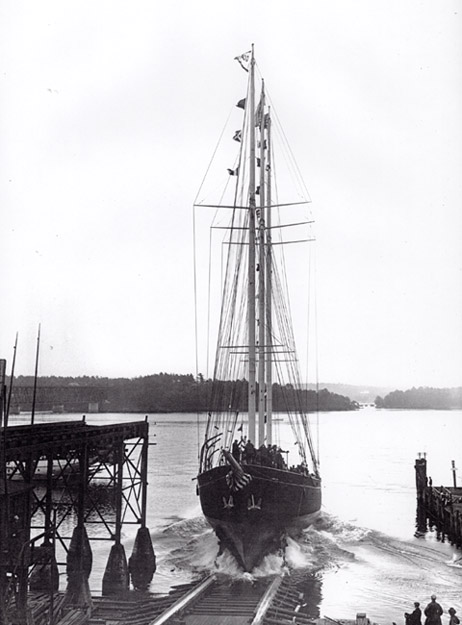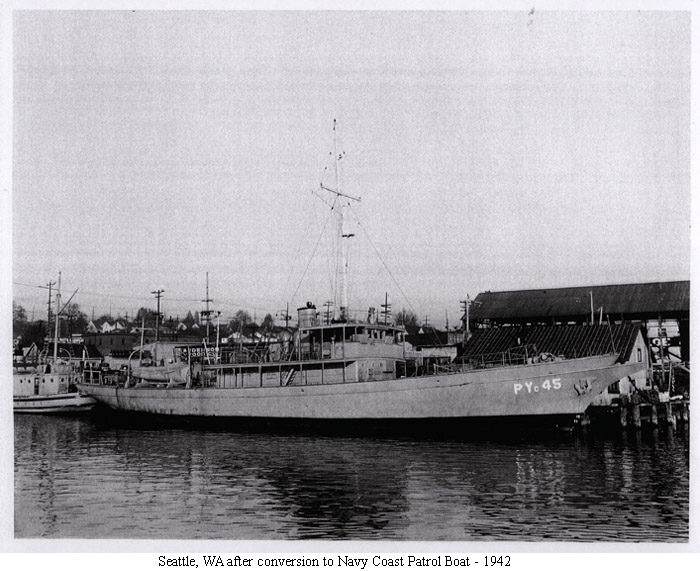
Wartime designation: Coastal Patrol Yacht 45 (PYc 45)
Type: Three-masted staysail auxiliary schooner
Ex; FWS-1105 (1941-42) IX-55 (Navy, 1942) PYc-45 (Navy, 1943) te Quest (1972-82) Aquarius, Aquarius W (1982-) El Boughaz I (2005-)
LOA: 175′ 0″ / 53.30m – LOD: 156’0″ / 47.55m – LWL: 118’0” / 35.97 – Beam: 32′ 0″ / 9.80m – Draft:12′ 0″ / 3.70m – Displacement: 371 tons – Engine(s): Twin 360 HP / 265 Kilowatts Volvo Pentas. – Fuel Capacity: 48000 L. – Fresh water: 40000.00. – Original Owner: Robert C. Roebling – Original Name: Black Douglas – Launched: 9 June 1930 – Designed by: H.J. Gielow & Co – Built by: Bath Iron Works, Bath, Maine – Hull Material: Wood – Sail area: 9,111 – IMO number: 6915946 – Flag: Cayman Islands – Status: In active service
Historical:
Black Douglas is a three-masted staysail auxiliary schooner built for Robert C. Roebling (great-grandson of John A. Roebling and grand-nephew of Washington Roebling) at the Bath Iron Works of Bath, Maine, and launched on 9 June 1930. Designed by renowned New York City naval architects H.J. Gielow & Co., she is one of the largest steel-hulled schooners ever built.

The ship’s 120-foot Douglas fir masts supported 9,111 square feet of sails that propelled the vessel. Auxiliary power was provided by twin 325-horsepower Cooper Bessemer diesel engines. These were later replaced with a 400-horsepower Enterprise diesel and then again with two Volvo diesel engines with twin shafts. The vessel was originally to be named Grenadier, but Mr. Roebling was persuaded by the Bath boatyard foreman to go with Black Douglas, after the famous Scottish knight. On her bow was placed a carved wooden figurehead of the knight.
The Roeblings and their friends sailed the Black Douglas on a maiden voyage through the Straits of Magellan at the southern tip of South America. In 1936, the family purchased the Modena Plantation on the north end of Skidaway Island, off the coast of Georgia. They then moved there from Trenton, New Jersey, and lived aboard the Black Douglas while the farm and living structures were being built onshore.
In September 1941, the Fish and Wildlife Service (FWS) purchased the ship following a special 30 June Congressional appropriation of $290,000 to begin the North Pacific fur seal investigation work. The Black Douglas was reconditioned in preparation for the work at Mingledorff’s shipyard in Savannah, Georgia.
The vessel, having been converted into a floating biological laboratory for seal research, set sail on 29 October 1941 for Seattle, Washington. Some sources suggest that the large lettering “UNITED STATES SEAL INVESTIGATION” was painted on her sides to help deter submarine attacks in the Atlantic and Carribean waters during World War II. Two months later, the 7 December bombing of Pearl Harbor brought the U.S. into the war. It is reported that while enroute to Seattle, the Black Douglas was fired upon by an enemy submarine off the Oregon coast and manage to escape by cutting her engine and blacking out.
Upon reaching Seattle, the ship requisitioned by the U.S. Navy, who then removed her figurehead and sailing gear (masts, spar, tackle, rigging, etc.). Four .50 caliber machine guns and sonar equipment were installed for military duty and on 18 April 1942, the USS Black Douglas was placed into service classified as the Miscellaneous Unclassified Auxiliary, IX-55. On 8 April 1943 she was reclassified as the coastal patrol yacht PYc-45 and commissioned on 19 April. That year, her engine was replaced with twin 450-horsepower Volvos connected to a single shaft. During the war, she patrolled the waters near Neah Bay off the Washington coast. After the war, the vessel was decommissioned at the Puget Sound Navy Yard on 20 September 1944.
She was removed from the Navy Register and returned to the Fish and Wildlife Service on 4 October 1944. At last the FWS had the Black Douglas available for its North Pacific fur seal project, however, two and a half years passed before the cruises actually began. During this time, the renovations and refitting were being made in Seattle to once again outfit the ship for the task at hand.
On 16 May 1947, the Black Douglas finally sailed northbound to begin the long-awaited studies of the Alaska fur seal herd. Headed by Dr. Victor Scheffer of the FWS, the work entailed tagging the seals and studying their feeding habits at the Pribilof Islands breeding grounds in the Bering Sea.
The Black Douglas followed the fur seal herd to ascertain alleged poaching threats and the seals’ migratory routes both to and from the Pribilof Islands. Druing the cruises, the crew also had the opportunity to study other marine mammals that potentially prey upon the young fur seals. That first year of the project, mechanical troubles prevented the vessel from trailing the seal herd further west than Attu Island at the end of the Aleutian chain. On 12 August, she returned to Seattle.
On 2 November 1948, the Black Douglas again sailed from Seattle north to the Pribilofs and Aleutian Islands to continue the fur seal study. The ship pursued the herd south as far as southern California to locate the wintering grounds before returning to port in late December. During the several 1947-49 cruises made from Alaska to California, almost 4 million seals were followed. These voyages also provided the opportunity to collect information from observing albatrosses at sea.
The captain and crew of the Black Douglas received commendations from the Secretary of the Interior as a result of their night rescue of 18 survivors from the Panamanian lumber ship Salina Cruz, which burned on 17 October 1949, about 100 miles off the coast of Oregon. Fortunately, the survivors, suffering from exposure, had been spotted in two lifeboats by Coast Guard planes.
The Black Douglas’ service in Alaska turned out to be short however. Following the fur seal cruises in 1949, the vesssel was moored at Treasure Island (San Francisco, California), used by the FWS to collect oceanographic data concerning currents and chemical/biological water characteristics. Late in 1949, the Black Douglas was reconditioned for oceanographic work and was relocated at La Jolla, California, near San Diego. Renovations included the installation of bathythermograph and plankton winches, and an overboard work platform. A wet laboratory was created from a portion of the galley.
From 1949-65, the Black Douglas was assigned to the Scripps Institution of Oceanography and Southwest Fisheries, and the California Department of Fish and Game for use in oceanographic cruises made between Oregon and Mexico. In 1949, the vessel and three other ships were involved in a coast-wide ocean pilchard research program. Other studies involved:
- Sardine spawning patterns off southern Califonia and Baja California (Jan-Feb 1951)
- Vertical distribution of southern California jack mackerel fish larvae (Apr 1955)
- Detailed physical and chemical hydrographic observations, and southern California egg and larval collections of sardine and other ecologically associated species, such as mackerel and anchovy (1956)
- Nightly plankton and temperature collections from areas frequented by the sardine fleet out of San Pedro, California (Oct-Dec 1957)
In 1965 the FWS descendant fisheries agency, Bureau of Commercial Fisheries (est. 1956), replaced the Black Douglas at La Jolla with the newly built research vessel David Starr Jordan. Bidding opened on 18 July 1966, for the auctioning of the Black Douglas. She was sold to Louis Black, a treasure hunter who used her to search for the sunken Spanish galleon Atocha.

The vessel was then sold in 1972 to the George Stoll family, owners of the Flint preparatory school in Sarasota, Florida. Sinc
e the ship was now showing severe wear from the many years of intensive use, she was fully remodeled, given new masts and renamed the te Quest. The revivied vessel partnered with another Flint boat, the te Vega, to visit various locations throughout Europe and the Mediterranean as a training ship for students learning to sail.
The Flint school was eventually disbanded in 1982 and the te Quest was sold to an investment group. The ship was brought to Germany, where, at a cost of $4 million, she was extensively restored as a luxury schooner at the Abeking and Rasmussen shipyard, and renamed Aquarius. During the 9 June 1996 weekend, the Aquarius (Black Douglas) returned to Skidaway Island for the first time in 55 years to celebrate her homecoming and 66th birthday. She also attended the Centennial Olympic Games which was being held at that time in Georgia.
In May 2003, the Aquarius was in Nice, France, under British registry, carrying a $1-2 million “historical” premium, and being offered for sale at a price of $6-7 million. She had additional maintenance and refitting work done in 2005 as a sailing yacht under the name El Boughaz I. Photos and references of the vessel found on the Internet dated as recently as 2009 showed her based out of France, apparently owned by King Mohammed VI of Morocco.
WWII service
Coastal patrol vessel in United States Navy service during World War II (PYc-45)
Provenance (The Wall of Remembrance – The Owners, Notable Guest, and Reunion Information):
Owner/Guardian: (1930) – Robert C. Roebling
Owner/Guardian: Louis Black of Santa Monica, California
Owner/Guardian: Capt. George Stoll
Owner/Guardian: SMCD Limited (King Mohammed VI of Morocco.)
Resources
NOAA Fisheries
NavSource
